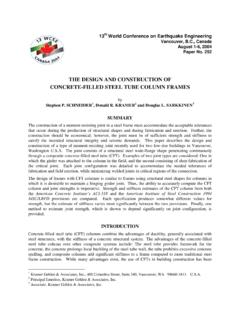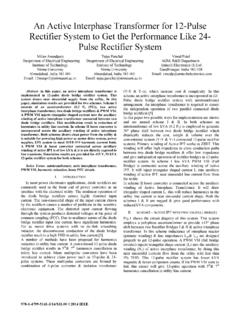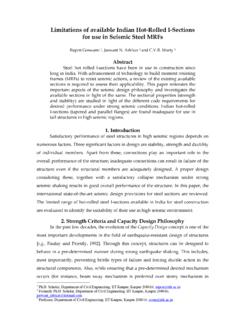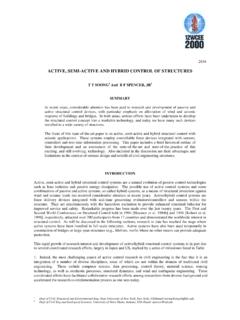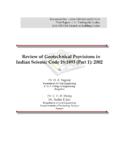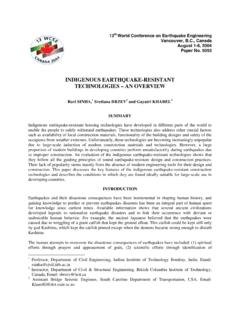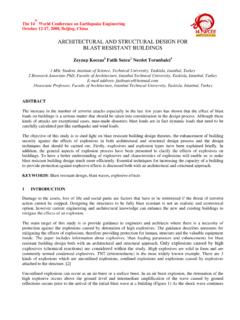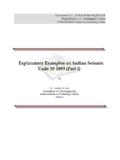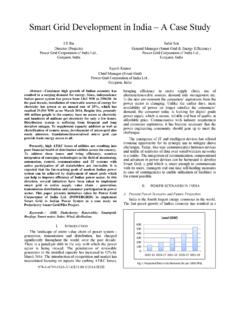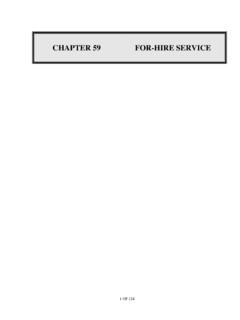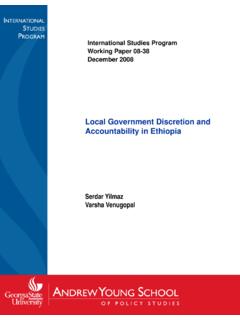Transcription of Bracing Systems for Seismic Retrofitting of Steel …
1 13th World Conference on Earthquake Engineering Vancouver, , Canada August 1-6, 2004 Paper No. 3351 Bracing Systems FOR Seismic Retrofitting OF Steel FRAMES Luigi DI SARNO1 and Amr S. ELNASHAI2 SUMMARY The present study assesses the Seismic performance of Steel moment resisting frames (MRFs) retrofitted with different Bracing Systems . Three brace configurations were utilized: special concentrically braces (SCBFs), buckling-restrained braces (BRBFs) and mega-braces (MBFs).
2 A 9-storey Steel perimeter MRF was designed with lateral stiffness insufficient to satisfy code drift limitations in zones with high Seismic hazards. The frame was then retrofitted with SCBFs, BRBFs and MBFs. Inelastic time-history analyses were carried out to assess the structural performance under earthquake ground motions. Local (member rotations) and global (inter-storey and roof drifts) deformations were employed to compare the inelastic response of the retrofitted frames.
3 It is shown that MBFs are the most cost-effective Bracing Systems . Maximum storey drifts of MBFs are 70% lower than MRFs and about 50% lower than SCBFs. Configurations with buckling-restrained mega-braces possess Seismic performance marginally superior to MBFs despite their greater weight. The amount of Steel for structural elements and their connections in configurations with mega-braces is 20% lower than in SCBFs. This reduces the cost of construction and renders MBFs attractive for Seismic Retrofitting applications.
4 INTRODUCTION Bracing is a very effective global upgrading strategy to enhance the global stiffness and strength of Steel and composite frames [1]. It can increase the energy absorption of structures and/or decrease the demand imposed by earthquake loads. Structures with augmented energy dissipation may safely resist forces and deformations caused by strong ground motions. Generally, global modifications to the structural system are conceived such that the design demands, often denoted by target displacement, on the existing structural and non-structural components, are less than their capacities (Figure 1).
5 Lower demands may reduce the risk of brittle failures in the structure and/or avoid the interruption of its functionality. The attainment of global structural ductility is achieved within the design capacity by forcing inelasticity to 1 Department of Structural Analysis and Design, University of Naples, Federico II, Italy, 2 Department of Civil and Environmental Engineering, University of Illinois, Urbana, IL 61801, USA. occur within dissipative zones and ensuring that all other members and connections behave linearly.
6 Displacement (%)Base Shear / Total Seismic Weight (%)Retrofitted StructureOriginal StructureOriginal Target DisplacementRetrofitted Target Displacement Figure 1. - Characteristics of global intervention approaches in Seismic Retrofitting . Bracing may be inefficient if the braces are not adequately capacity-designed [2]. Braces can be aesthetically unpleasant where they change the original architectural features of the building [3, 4]. In addition, braces transmit very high actions to connections and foundations and these frequently need to be strengthened.
7 Several configurations of braced frames may be used for Seismic rehabilitation. The most common are concentric braced frames (CBFs), eccentric braced frames (EBFs) and the novel knee-brace frames (KBFs), recently proposed for earthquake loads [5, 6]. The existence of tension/compression braces in CBFs results in a lateral stiffness well above that of MRFs. However, due to buckling of the compression members (struts) and material softening due to the Bauschinger effect, the hysteretic behaviour of CBFs is unreliable.
8 It follows that the key to improving Seismic behaviour depends on the scrupulous design of Bracing members [7]. Common configurations for CBFs include V and inverted-V bracings, K, X and diagonal bracings. However, V bracings are not advised for Retrofitting because of the likelihood of damage in the beam mid-span. Under horizontal forces the compressed braces may buckle, thus reducing their load bearing capacity abruptly. Conversely, the force in the tension braces increases monotonically reaching yield strength and eventually strain-hardening.
9 The net result is an unbalanced force concentrated at the brace-to-beam connection. The effects in the beam, , additional bending and shear, should be added to those due to gravity loads [8]. Alternatively, the unbalanced force in the beams may be eliminated through ad hoc Bracing configurations such as macro-bracings, , two, three storey X-bracings or V-bracings with a zipper column [9]. Macro-bracings can be utilised for strengthening and stiffening of Steel and composite Steel -concrete buildings.
10 They are often employed to form MBFs, which exhibit high stiffness and enhanced ductility. Brace configurations with MBFs have been utilised in the present analytical work to retrofit a medium-rise Steel MRF with inadequate lateral stiffness. Alternative Systems , such as traditional SCBFs and frames with unbounded braces, have also been assessed. Unbounded braces are becoming very popular in Japan and the US for Seismic Retrofitting [10]. These braces are based on the same metallic yielding principle of added-damping-added-stiffness (ADAS) devices, , tension/compression yielding brace.

